Diplomatic Bluebook 2016
Chapter 2
Japan’s Foreign Policy that Takes a Panoramic Perspective of the World Map
3.Southeast Asia
(1) Indonesia
In Indonesia, Joko Widodo was elected as President at the presidential election carried out in July 2014, and was inaugurated as the 7th president in October of the same year. President Joko in April 2015 hosted the 60th Bandung Conference Commemoration in Indonesia. In domestic policy, he has put emphasis on economic measures, announcing a series of economic policy packages containing deregulation with the world economy slowing-down.
In terms of the relationship with Japan, Indonesia continued talks at leader and minister levels actively even after the inauguration of the Joko administration, facilitating communication between the two countries. In March, President Joko visited Japan and held a summit meeting. After the meeting, the leaders of Japan and Indonesia issued a joint statement entitled, “Japan-Indonesia Joint Statement - Toward further strengthening of strategic partnership supported by the seas and democracy,” and confirmed a strengthening of the strategic partnership supported by the seas and democracy, based on mutually beneficial cooperation, friendly relations and sharing of fundamental values. When Prime Minister Abe visited Indonesia in April to attend a summit meeting commemorating the 60th anniversary of the Asian-African Conference (Asian African Summit 2015), a bilateral summit meeting took place between Japan and Indonesia, followed by another bilateral summit meeting organized on the occasion of an ASEAN-related summit meeting (in Malaysia) in November. In addition, Foreign Minister Kishida met with Foreign Minister Retno when the latter visited Japan in December. Furthermore, a Foreign and Defence Ministerial Meeting was held between Japan and Indonesia for the first time, wherein it was confirmed that the two countries will strengthen security and defense cooperation, and continue to work closely for the sake of peace, stability and prosperity in the region and the world.
Other exchanges included visits of Vice President Kalla to Japan in March and in May, and visits to Indonesia of Japan’s economic organizations and a delegation for Japan-Indonesia cultural, economic and tourism exchanges involving a total of more than 1,000 people.
(2) Cambodia
Cambodia is situated in a strategic point of the Southern Economic Corridor, and serves as a key country in strengthening connectivity and narrowing regional development gap in the Mekong region. The country has been promoting a development policy with emphasis on the enhancement of governance, with the aim of entering the group of Upper Middle Income Countries in 2030.
Japan has been cooperating actively with Cambodia, including through the Cambodia peace process in the late 1980s and in its subsequent reconstruction and development process. Thus the two countries remain in a good relationship. The year 2015 marked the 60th anniversary of the signing of the Japan-Cambodia Friendship Treaty. In this memorial year, Japan and Cambodia made efforts for further strengthening the “strategic partnership” upgraded by the two leaders in 2013. A summit meeting was held three times in 2015: When Prime Minister Hun Sen visited Japan to attend the UN World Conference on Disaster Risk Reduction in March and to attend the Japan-Mekong summit meeting in July, and on the occasion of the ASEAN-related summit meeting (Malaysia) held in November. Prime Minister Hun Sen expressed again great appreciation and support for Japan’s “Proactive Contribution to Peace,” as well as gratitude for Japan’s support for election reform. In April, the Neak Loeung bridge constructed by Japan’s ODA was opened, and Prime Minister Hun Sen named it “Tsubasa” bridge. In June, the funeral of Chea Sim, former President of the Senate was held, attended by Ryu Shionoya, a member of the House of Representatives (Chairman of Japan-Mekong Parliamentary Friendship) as the Prime Minister’s Special Envoy. In October, Parliamentary Vice-Minister for Foreign Affairs Kazuyuki Nakane visited Cambodia. In December, members of Japan-Cambodia Parliamentary Friendship League also took the opportunity of the 50th anniversary of Japan Overseas Cooperation Volunteers (JOCV) to visit the country.
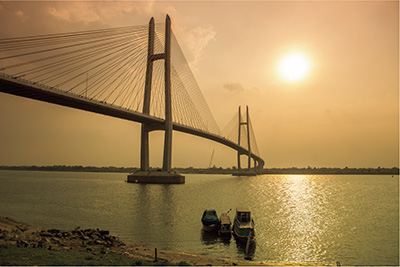 Neak Loeung Bridge (Tsubasa-bashi) construction plan (Cambodia)
Neak Loeung Bridge (Tsubasa-bashi) construction plan (Cambodia)In domestic affairs, the ruling and opposition parties confronted each other over election results in the National Assembly (Lower House) in 2013. After the ruling and opposition parties agreed to a breakthrough for the political situation in July 2014, two laws were enacted in 2015: the Law on the Organization and Functioning of the National Election Committee and the revised Election Law, enabling the new National Election Committee to start operation. On the other hand, the confrontation between the ruling and opposition parties is also seen to have grown, including with the arrest warrant issued for the opposition leader in November, with local elections scheduled in 2017 and national election scheduled in 2018.
(3) Singapore
A general election took place in September, in which the ruling People’s Action Party (PAP) led by Prime Minister Lee Hsien Loong won an overwhelming 83 of 89 seats, remaining in power. The general election drew attention concerning how much the ruling party’s policy following the last general election of 2011 was accepted by the people. The considerate and precise implementation of policy management on actively accepting foreigners with due consideration to public willingness was evaluated, including reviewing part of the proactive foreigner acceptance policy, enhancement of the education system other than university education, expansion of support for the elderly and low-income earners, and improvement of housing conditions, leading to a reversal of the falling trend in support for the ruling party. Following the general election’s results, a large-scale cabinet reshuffle was conducted in October, allowing new ministers to be appointed for eight of a total of 15 ministries. Generation change in the leadership has also been in steady progress, as shown by the new ministers appointed from among next-generation leadership candidates referred to as the “fourth generation.”
In the relationship with Japan, VIP visits actively took place in 2015 following the previous year. In March, Prime Minister Abe visited Singapore to attend the state funeral of Lee Kuan Yew, the former Prime Minister and the founding father of Singapore. His visit was the third in three consecutive years. The two leaders also had bilateral talks at the ASEAN-related summit (in Malaysia) held in November, and confirmed further strengthening of cooperation between the two countries. At the ministerial level, Foreign Minister and concurrent Minister of Justice Shanmugamu visited Japan in March to meet with Foreign Minister Kishida. At the meeting, they agreed to continue to strengthen cooperation toward the 50th anniversary after the establishment of diplomatic relations between the two countries in 2016.
On the economic front, a number of Japanese companies have established regional headquarters in Singapore, and cooperation between corporations from the two countries continues to progress in the area of infrastructure, etc. Furthermore, the two countries work together to actively carry out technical cooperation as well as intellectual and cultural exchanges targeting developing countries through the “Japan-Singapore Partnership Program 21 (JSPP21).”
(4) Thailand
Thailand is situated in the center of the Mekong region, and is one of the major countries in Southeast Asia. There exists a “strategic partnership” relationship between Japan and Thailand. Furthermore, a lot of Japanese companies are doing business based on investment accumulated over the years. Nowadays, they serve as an essential part of supply chains on a global scale for the Japanese economy.
The society is deeply divided, depending on public opinions denouncing or supporting former Prime Minister Thaksin after he was forced from political power by a coup in 2006. Amid such a situation, demonstrations and violent incidents caused government functions and civic life to be continuously affected from 2013 to 2014. In response, a coup was staged mainly by the military claiming to cope with the situation in May 2014. Under the parliament and interim cabinet established by the military government, a new constitution drafting process is under way. It is not likely before the end of 2017 that democracy will be restored through the implementation of parliamentary elections.
Various levels of exchanges, including political and economic, have been carried out between Japan and Thailand on the foundation of the close relationship between the imperial and royal families. To boost the stabilization and restoration of democracy in Thailand and to deepen the relations between the two countries, a summit meeting was held four times in 2015 (visit to Japan (February), the Third United Nations World Conference on Disaster Risk Reduction (March), the 7th Japan-Mekong region countries summit meeting (July) and ASEAN-related summit meeting (November)). In November, Deputy Prime Minister Somkid visited Japan with major economic ministers.
In addition, as a result of a visa exemption Japan started in 2013 for Thai short-term travelers, Thai visitors to Japan totaled about 800,000 (about three times as many as before the visa exemption) in 2015. The increasing trend is continuing thereafter.
(5) Timor-Leste
Timor-Leste is the first independent country for the 21st century, and has achieved the peace and stability under the support of the international community. Nation-building based on democracy is ongoing under President Rourke elected in 2012 and Prime Minister Araujo appointed in 2015. In July 2011, a “Strategic Development Plan (SDP)” (long-term guidelines for development policy up until 2030) was formulated, and the country is currently proceeding from the stage of post-conflict reconstruction to the stage of full-scale development. In July, a ministerial meeting of the Community of Portuguese Language Countries (CPLP)1 was held in Dili, attended by Parliamentary Vice-Minister for Foreign Affairs Nakane from Japan as an observer.
Japan continues to fully boost the efforts of Timor-Leste, which has shifted to a new stage of full-fledged economic growth and development through post-conflict reconstruction, while continuously maintaining close cooperation in the international arena, etc. Japan supports Timor-Leste’s targeted policy of acceding to ASEAN smoothly, and assists in human resources development toward the accession.
Mutual VIP visits continued to take place actively, including a visit to Timor-Leste by Special Advisor to the Prime Minister Taro Kimura and a visit to Japan of Foreign Cooperation Minister Coelho, in addition to a visit by Parliamentary Vice-Minister for Foreign Affairs Nakane.
- 1 Timor-Leste hosted the CPLP summit in July 2014, which was the first international conference the country organized.
(6) The Philippines
In January, the Philippine National Police Special Action Force and the Moro Islamic Liberation Front (MILF) clashed in Mamasapano, a Province of Maquindanao, Mindanao in southern Philippines. The incident caused casualties on both sides. The Philippine government and the MILF signed a comprehensive peace agreement in March 2014, and were preparing for establishing a new autonomous government in Mindanao. In response to this incident, however, a bill to establish an autonomous government has not been deliberated smoothly in the Philippines Congress, causing a delay in the peace process.
After the clash in Mamasapano, the approval rate of President Aquino fell temporally, but then recovered to 58% in the December survey. The term of office of President is defined as six years (without re-election), pursuant to the provisions of the Philippine Constitution. Thus President Aquino is to finish his term of office at the end of June 2016. The next presidential election is scheduled for May 2016. President Aquino appointed Interior Home Affairs Minister Roxas as his successor in July 2015.
With regard to the dispute over the South China Sea with China, the Philippines government has been proceeding with arbitration based on the UN Convention on the Law of the Sea. The Arbitration Tribunal admitted jurisdiction over part of the Philippines’ submissions in October, and held an oral proceedings on merits in November.
In June 2015, the Government of Japan invited President Aquino as a State Guest. During his stay in Japan, President Aquino attended events at the Imperial Palace including State Banquet, had a summit meeting and dinner with Prime Minister Abe and participated in the Philippine Investment Forum organized by the business community. He also gave a speech at the House of Councillors in the Diet. The Philippines hosted the Asia-Pacific Economic Cooperation (APEC) as Chair in November 2015. This provided an opportunity for Prime Minister Abe and Foreign Minister Kishida to visit the Philippines to respectively attend a summit meeting and a foreign ministers’ meeting.
In January 2016, Their Majesties the Emperor and Empress visited the Philippines. Their Majesties the Emperor and Empress had visited the Philippines as Crown Prince and Crown Princess in 1962, but the latest visit to the country was the first visit as Emperor and Empress. Their Majesties attended a welcoming ceremony and State Banquet hosted by President Aquino at the Philippine presidential palace, and met with former students on government scholarship and ex-trainees having studied in Japan, as well as nurse and care worker candidates receiving Japanese language training before visiting Japan. Their Majesties also visited the Philippines Monument to the War Dead in Caliraya, Laguna Province, and laid flowers at the site.
The Philippines, a major member country of the Association of Southeast Asian Nations (ASEAN), has attracted the world’s attention by achieving high economic growth in recent years under the leadership of President Benigno S. Aquino III, who took office in June 2010. In June 2015, the Japanese Government invited President Aquino as a state guest. The Japan-Philippines relations were further strengthened and upgraded to a new height through the state visit of the President to Japan.
1 Confirmation of friendly relations built between the two countries in the post-war period
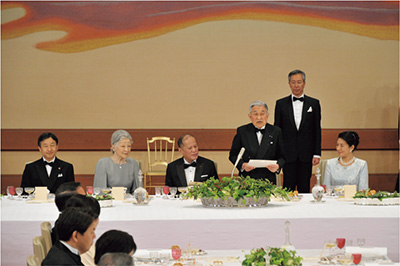 The State Banquet at the Imperial Palace (June 3, Photo: Imperial Household Agency)
The State Banquet at the Imperial Palace (June 3, Photo: Imperial Household Agency)During World War II, the Philippines was caught up in fierce fighting between Japan and the U.S., and many local Filipinos lost their lives. For some time after the war, people had harsh feelings toward Japan in the Philippines, but Japan and the Philippines normalized diplomatic relations in 1956 and, since then, the relationship has been steadily improving. At present, the Philippines is said to be one of the most pro-Japanese countries in the world. During his visit to Japan, President Aquino made the following comments on the development of friendly relations built between the two countries in the post-war period:
〈Excerpt from President Aquino’s speech at State Banquet at the Imperial Palace〉
“The pain and tragedy of the past have been healed by Japan’s commitment to a relationship based on mutual respect, dignity and solidarity. For 59 years, our two nations have demonstrated that we can work together for our advancement and mutual benefit.”
2 Deepening of bilateral cooperation as a Strategic Partner
 The summit meeting (June 4, Photo: Cabinet Public Relations Office)
The summit meeting (June 4, Photo: Cabinet Public Relations Office)In September 2011, Japan and the Philippines placed their bilateral relations as a “Strategic Partnership.” Prime Minister Abe has held a summit meeting with President Aquino each year since he took office to strengthen the relationship. On this occasion of President Aquino’s visit to Japan, a summit meeting took place at the State Guest House, Akasaka Palace, and a joint declaration was issued. The joint declaration confirms that the more enhanced relations of the two countries have entered into a Strategic Partnership stage.
As a symbol of bilateral cooperation, joint development of infrastructure will be implemented in Metro Manila. Metro Manila is faced with chronic traffic congestion, and there is a pressing need to improve the situation. At the summit meeting, the two countries decided to work together to develop the infrastructure pertaining to the transportation sector of Metro Manila, and agreed to a roadmap including specific projects (railway maintenance, etc.) to facilitate the development.
(7) Brunei
Brunei was achieving high economic levels and excellent social welfare, thanks to rich natural resources, but the economic growth rate has fallen in the past few years, caused by falling crude oil and natural gas prices.
Japan and Brunei have maintained a good relationship based on the foundation of a stable supply of liquefied natural gas (LNG) that has been continuing for many years. Japan intends to actively contribute to industry diversification, in which Brunei is making efforts. Furthermore, Brunei has been serving as the ASEAN Dialogue Coordinator for Japan since August 2015 for the following three years.
In October, King Hassanal Bolkiah carried out cabinet reshuffle for the first time in five years. State Minister for Foreign Affairs Seiji Kihara visited Brunei in late October to have talks with high-ranking government officials. It was confirmed at the meeting that the two countries would strengthen bilateral relations, and cooperation in the region and in the international arena.
(8) Viet Nam
Located next to sea lanes in the South China Sea and having a long border line with China, Viet Nam is a geopolitically important country. Given that the country embraces the 3rd largest population in Southeast Asia, and experiencing a surge in the number of those in middle-income brackets, Viet Nam is becoming a promising market. While the economy slowed down from the late 2000s, it is on a recovery trend in recent years thanks to efforts for macro-economic stabilization such as curbing inflation, and foreign investment promotion through development of infrastructure and improvement of investment environment. Furthermore, the country is working on a reform of the financial sector and state-owned enterprises, and participated in the negotiations for the Trans Pacific Partnership (TPP) agreement to diversify the economy.
With regard to domestic affairs, the National Congress of the Communist Party of Viet Nam (CPV), regularly organized every five years, was convened in January 2016. General Secretary Trong was re-elected, and the new leadership of the party was inaugurated. At the 11th session of the 13th National Assembly to be convened from March to April 2016, the president as the head of state and the prime minister are to be elected. In Viet Nam adopting a collective leadership, a significant change in policy on domestic and external affairs is unlikely. In recent years, awareness about the importance of incorporating democratic elements is gradually increasing even under the one-party leadership, as seen by the fact that a vote of confidence is implemented for the ministers in the national assembly and for the Politburo and Secretary members in the Communist Party.
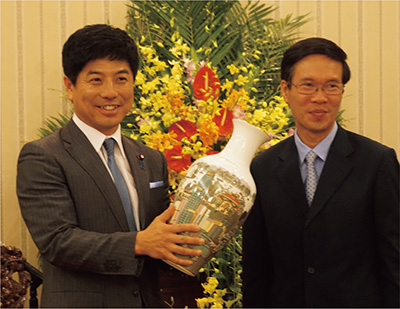 Parliamentary Vice-Minister for Foreign Affairs Nakane meeting with Deputy Secretary of Party Committee Thuong, Ho Chi Minh City (August 29, Ho Chi Minh City, Vietnam)
Parliamentary Vice-Minister for Foreign Affairs Nakane meeting with Deputy Secretary of Party Committee Thuong, Ho Chi Minh City (August 29, Ho Chi Minh City, Vietnam)Viet Nam is seen to have a sense of vigilance against China over the situation in the South China Sea, given the situation in which China continues land reclamation and the construction of outposts in the Spratly Islands and installing oil rigs in the waters around the Paracel Islands. In terms of relations with the United States, the relationship is developing, as the General Secretary of the Communist Party of Viet Nam visited the U.S. for the first time since the end of the Viet Nam War in July 2015.
Japan is the largest donor of official development assistance (ODA) and the second largest investor country for Viet Nam. Japan-Viet Nam relations have been progressing in a wide range of fields, such as economic cooperation, security and cultural exchange, based on “the Extensive Strategic Partnership. ”Mutual high-level exchanges are continuing, including the followings: Prime Minister Dung visited Japan to attend the Japan-Mekong summit meeting held in July, and General Secretary Trong visited Japan as an official guest in September 2015.
Myanmar, freed from a prolonged military regime, has been rapidly working toward democratization under the Thein Sein administration, by conducting an inclusive general election which took place on November 8.
Until the election day, skeptical reports regarding whether or not a free and fair general election would be carried out in Myanmar dominated in the international community. On the day before the election, I visited seven polling stations as chief of the Japanese election observation team in Myanmar. Wherever we went, our visit was welcomed and each officer in charge responded to our questions with a smile. At a certain polling station, there were four voting spots in the narrow space. Despite our worry that the crowded voting spots might confuse voters, an officer was confident that there would be no problem since people had been well informed in advance by staffs. On the voting day, when we arrived at the polling station early in the morning - at 5:30 a.m., more than 100 voters were already waiting calmly in a queue. Once the polling station was opened, they proceeded to their voting spot without any confusion to cast their vote, just as had been instructed by the official in charge on the previous day. Since the voting was scheduled to end at 4:00 p.m., there was a concern about how to deal with voters who arrive late at the polling station. It was decided that voters who enter the voting sites by 4:00 p.m. would be allowed to cast their vote. There seem to be no cases where a lot of voters rushed in around 4:00 p.m. at any voting site.
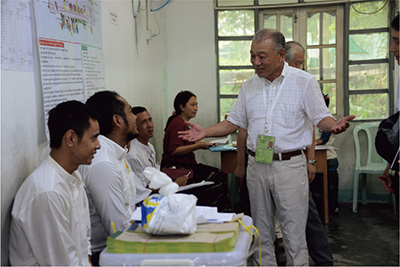 The author meeting with the staff before the voting
The author meeting with the staff before the voting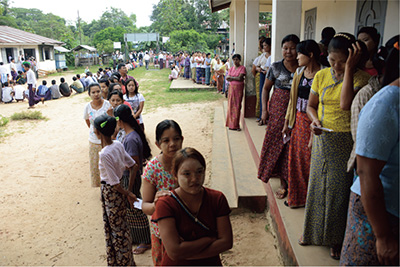 Local residents lining up in a queue for the voting
Local residents lining up in a queue for the votingThe ballot counting started in the evening of the voting day. I sat on the front row together with political party representatives of the candidates and observers from Australian, Thai and Dutch teams and monitored the counting. Ballot counting started with nearly 200 advance votes. Officials in charge showed us the ballot papers one by one and put them into the boxes according to faction, writing down the number of votes per faction on the board as well. With regard to invalid votes, the reasons for invalidity were explained to witnesses from concerned parties before nullifying the votes. For this reason, it took almost one hour to count nearly 200 votes, but it was a very fair and accurate vote counting. To prevent double voting, it was a rule to put ink on the little finger of those who have already voted. The ink was indelible for 48 hours and was partly provided by the Japanese Government. It was impressive that all voters were showing to each other their little fingers marked with ink after voting, with smiling faces, full of joy that a vote of each one of them had a role in the country’s politics.
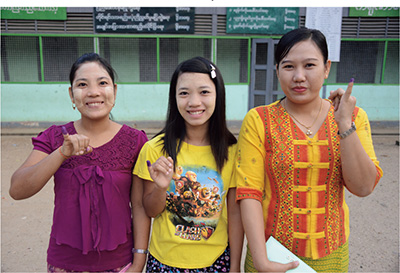 The indelible ink on the little finger is a testament to voting
The indelible ink on the little finger is a testament to voting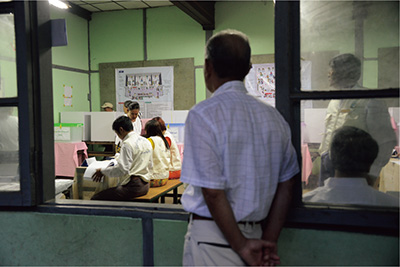 The author watching vote counting
The author watching vote countingAt polling stations, a total of 10,000 observers composed of 1,000 foreign election monitoring mission members and 9,000 domestic election monitoring mission members monitored the election. We discussed impressions of the election with the United States and European Union monitoring mission teams. We all shared the view that a free and fair election was held.
Watching a queue of people quietly waiting for more than an hour to vote in the hot weather, a scene quite different from the skeptical news reports before the election, I once again realized the importance of one vote.
In Japan, the voting age will be lowered to 18 this year. I hope young people in particular will have an interest in elections.
(9) Malaysia
The Najib administration, has been steadily implementing a “government transformation program,” a “new economic model,” the “10th Malaysia Plan” and an “economic transformation program” under the slogan of “One Malaysia (nation first, prompt execution).” All of these programs were announced in 2010 to facilitate ethnic reconciliation, the enhancement of administrative reform and the improvement of public welfare. The country, with the aim to enter the group of advanced countries by 2020, proceeds with deregulation and liberalization to strengthen international competitiveness, while maintaining a steady growth at home, supported by investment and domestic consumption. In 2015, Malaysia served as Chair for ASEAN.
Concerning its relationship with Japan, the leaders of the two countries mutually visited again in 2015, following on from visits in 2013 and 2014. In May, Prime Minister Najib visited Japan as a dignitary for an official working visit, and met with Prime Minister Abe. The two leaders agreed to upgrade bilateral relations to a “strategic partnership,” thereby continuing to strengthen cooperation on a wide range of issues in the regional and international communities. When Prime Minister Abe visited Malaysia to attend an ASEAN-related summit meeting in November, a bilateral summit meeting was held between the two leaders.
On the economic front, close cooperation continues, as shown by the fact that Japan is the largest investor for Malaysia and the number of Japanese-affiliated companies operating in Malaysia amounts to as many as 1,400.
The Look East Policy2, which serves as a foundation for the good bilateral relationship, celebrated its 30th anniversary in 2012. In this program, about 15,000 people have studied or have been trained in Japan so far, and a program referred to as “Look East Policy 2.0” is under consideration to improve the quality of the Look East Policy, including increases for the number of people studying abroad. The two countries are cooperating in making the Malaysia Japan International Institute of Technology (MJIIT), which was established in September 2011, a base for Japanese-style engineering education in ASEAN. The possibility of cooperation is also being studied on a high-speed railway project between Malaysia and Singapore.
- 2 A policy proposed by (then) Prime Minister Mahathir in 1981, with an aim to develop the economy by learning labor theory and management philosophy from Japan and the ROK.
The year 2015 falls on the 60th anniversary since diplomatic relations were established between Japan and Laos. The relationship between the two countries developed gently and steadily during that period, although it went through little twists and turns including a regime change in Laos. The two countries now enjoy a “Strategic Partnership” with each other. I call it a “heart-to-heart partnership,” because warm and heat-to-heart contact can be seen in the relations with Laos at governmental and diplomatic levels, as well as at private sectors. Although Laos may not be a very popular country in Japan, there are more than ten friendship and exchange organizations across the country, which are performing a variety of activities.
In celebration of the “60th anniversary,” we, the “Japan-Laos Friendship Association” organized a visit of delegation to have exchanges with relevant people in the public and private sectors, and dispatched a delegation of approximately 150 high-profile people from relevant organizations to Laos on November 11. Our association is a private organization but we sincerely hoped to give a banquet to symbolize a celebration which “the whole nation is involved in.” So, we held one on November 12 with a total of about 250 people present, obtaining the support of the Japanese Embassy there. The attendees included high-profile government officials and people relevant to Japan from the Laos side, including Deputy Prime Minister Dr. Phan Kham, and from the Japanese side, the Parliamentary Vice-Minister for Foreign Affairs, Ambassador Kishino and Japanese nationals living there. (Photo 1: The author greeting on behalf of the organizers.). The delegation participated in the opening ceremony of the “Japan Festival” held to commemorate the “60th anniversary”, and split into groups to pay courtesy calls on dignitaries, take part in an economic symposium and visit factories.
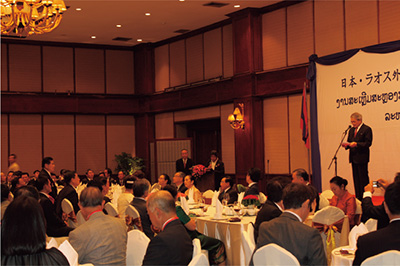 Photo 1: The author greeting on behalf of the organizers at the celebration
Photo 1: The author greeting on behalf of the organizers at the celebration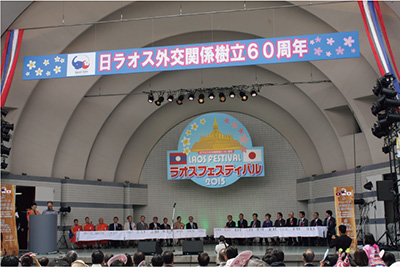 Photo 2: Festival
Photo 2: FestivalKawasaki Chamber of Commerce and Industry, Saitama Laos Friendship Association and Sakura International High School that composed the delegation have a proven track record of actively facilitating exchange with Laos. Sakura International High School students performed at the banquet and the “Japan Festival,” and drew a big round of applause.
The “Laos Festival” organized to commemorate the “60th anniversary” in the efforts of our association and these organizations including Sakura International High School also deserves special mention. This is the celebration event held at Yoyogi Park on May 23 and gained a participation of the minister in charge who came all the way from Laos. The event was organized by the Executive Committee set up in cooperation with the Embassy of Laos in Tokyo. (Photo 2: The opening ceremony of the festival.). The song & dance ensemble dispatched by the Lao government and various arts organizations in Japan gave a variety of performances for two entire days. According to the Executive Committee, a total of about 200,000 visitors appreciated the performances and enjoyed the exhibitions, products and food from Laos at the stalls at the venue over two days.
(10) Myanmar
In Myanmar, since the transition to civilian rule in 2011, reform has been promoted under President Thein Sein, including democratization, national reconciliation, economic reform, and strengthening of the rule of law. In November, the first general election after the transition to civilian rule in 2011 was carried out in a generally peaceful manner, and the National League for Democracy (NLD), led by Chairperson Aung San Suu Kyi won nearly 60% of all seats. In response to this, a new government is to be inaugurated in late March 2016. Aside from this, a positive move toward national reconciliation was observed, such as the signing of a cease-fire agreement between the Myanmar government and eight ethnic armed groups in October 2015.
Myanmar is situated in a geographically important region between China and India, providing high potential for development. Furthermore, since Myanmar citizens are generally friendly to Japanese people, Japanese companies indicate high interest. In light of these points, Japan expects Myanmar to develop as a country contributing to the prosperity and stability in the region by boosting its efforts for reform.
Meanwhile, President Thein Sein visited Japan to attend the 7th Japan-Mekong Summit in July. President Thein Sein also had a bilateral meeting with Prime Minister Abe. At the meeting, Prime Minister Abe expressed that, to contribute to the peace and stability in the region through the “proactive contribution to peace,” both public and private sectors will need to jointly support democratization and social and economic reforms in Myanmar. He also committed to boosting the peace process in the country together with Yohei Sasakawa, Special Envoy of the Government of Japan for National Reconciliation in Myanmar and providing ODA loans totaling about 100 billion yen. Furthermore, on the occasion of the Mekong-Japan Summit, Japan, Thailand and Myanmar signed a memorandum of intent related to the Dawe Special Economic Zone in the south of Myanmar, and reaffirmed cooperation for the development of the Dawe Special Economic Zone.
With regard to the above-mentioned general election, Japan dispatched a Japanese government election observer mission headed by Yohei Sasakawa, Special Envoy of the Government of Japan for National Reconciliation in Myanmar, taking into consideration the importance of implementing and supporting a free and fair election in the process of democratization in Myanmar.
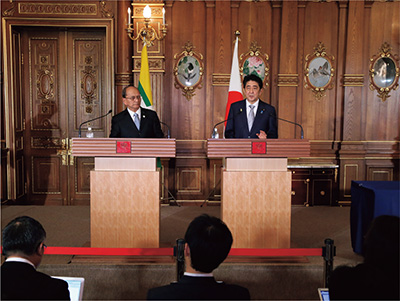 Japan-Myanmar summit meeting (July 4, Tokyo; Photo: Cabinet Public Relations Office)
Japan-Myanmar summit meeting (July 4, Tokyo; Photo: Cabinet Public Relations Office)(11) Laos
Laos is a landlocked country bordering the five countries of China, Myanmar, Thailand, Cambodia and Viet Nam. The country is the key of the Mekong region. Economic development was delayed due to the geographical constraints and effects of the past civil war. In recent years, however, the country focuses on the geographical advantage of being located in the center of the Indochina to become a base for regional logistics through the improvement of the regional connectivity, thereby leading to its economic development. Internal politics are generally stable under the one-party rule system by the People’s Revolutionary Party. Strong economic growth also continues in the country, led by the power generation and mineral resources sectors.
Japan and Laos in 2015 marked the 60th anniversary of the establishment of diplomatic relations, and upgraded the bilateral relationship to a “strategic partnership.” A leader-level of exchange activated in 2015, as shown by the summit meeting between Japan and Laos held three times in that single year. A variety of events commemorating the 60thanniversary also took place in both countries, further deepening mutual understanding at the grassroots level. In recent years, Japanese companies have been showing a growing interest in Laos. Thus not only conventional development cooperation but also economic exchanges including private investment are increasing, as shown symbolically by a local office opened by the Japan External Trade Organization (JETRO) in July 2014.



